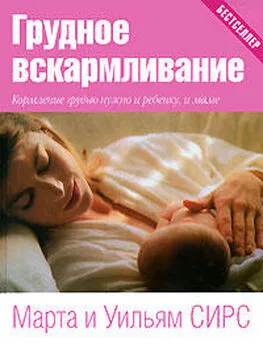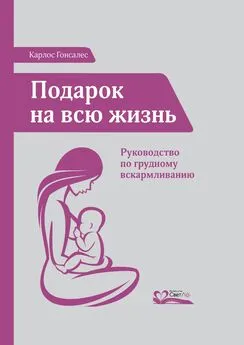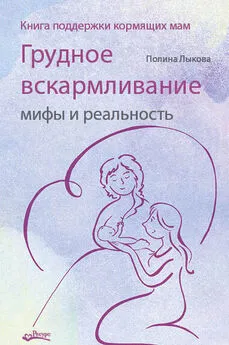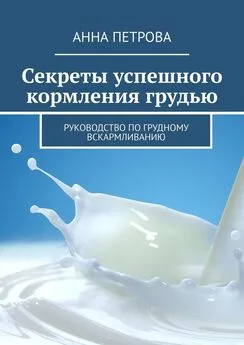Дайен Виссингер - Искусство грудного вскармливания
- Название:Искусство грудного вскармливания
- Автор:
- Жанр:
- Издательство:Эксмо
- Год:2012
- Город:Москва
- ISBN:978-5-699-54550-6
- Рейтинг:
- Избранное:Добавить в избранное
-
Отзывы:
-
Ваша оценка:
Дайен Виссингер - Искусство грудного вскармливания краткое содержание
Искусство грудного вскармливания - читать онлайн бесплатно полную версию (весь текст целиком)
Интервал:
Закладка:
412 много молока
Butler, K. and S. Upstone. 2009. Too Much Milk. LLLGB.
Livingstone, V. 1997. The maternal hyperlactation syndrome. Medicine North America 20(2):42–46.
Smillie, C.M. et al. 2005. Hyperlactation: how left-brained rules for breastfeeding can wreak havoc with a natural process. Newborn Infant Nurs Rev 5(1):49–58.
Van Veldhuizen-Staas, C. 2007. Overabundant milk supply: an alternate way to intervene by full drainage and block feeding. Int Breastfeed J 2(11).
Wilson-Clay, B. 2006. Milk oversupply. J Hum Lact 22(2):218–220.
415 молочница
Brent, N.B. 2001. Thrush in the breastfeeding dyad: Results of a survey on diagnosis and treatment. Clin Pediatr (Phila) 40(9): 503–6.
da Costa Zцllner, M.S.A. and A.O. Jorge. 2003. Candida spp. occurrence in oral cavities of breast feeding infants and in their mothers’ mouths and breasts. Pesqui Odontol Bras 17(2): 151–5.
Francis-Morrill, J. et al. 2005. Risk factors for mammary candidosis among lactating women. J Obstet Gynecol Neonatal Nur 34(1):37–45.
Francis-Morrill, J. et al. 2003. Detecting Candida albicans in human milk. J Clin Microbiol 41(1):-475–478.
Francis-Morrill, J.et al. 2004. Diagnostic value of signs and symptoms of mammary candidosis among lactating women. J Hum Lact 20(3): 288–94.
Graves, S. et al. 2003. Painful nipples in nursing mothers: fungal or staphylococcal? A preliminary study. Aust Fam Physician 32(7):570–1.
Hale, T.W. et al. 2009. The absence of Candida albicans in milk samples of women withтclinical symptoms of ductal candidiasis. Breastfeed Med 4(2):57–61.
Panjaitan, M. et al. 2008. Polymerase chain reaction in detection of Candida albicans for conf irmation of clinical diagnosis of nipple thrush. Breastfeeding Med 3(3):185–187.
Wiener, S. 2006. Diagnosis and management of Candida of the nipple and breast. J Midwifery Womens Health 51(2):125–8.
416 молочный пузырек
Huml S. 1999. Sore nipples. A new look at an old problem through the eyes of a dermatologist.Pract Midwife 2(2):28–31.
418 нагрубание
Academy of Breastfeeding Medicine Protocol Committee. Berens P. 2009. ABM clinical protocol #20: Engorgement. Breastfeed Med 4(2):111–113.
Arora, S. et al. 2008. A comparison of cabbage leaves vs. hot and cold compresses in the treatment of breast engorgement. Indian J Community Med 33(3):160–162.
Cotterman, K.J. 2004. Reverse pressure softening: a simple tool to prepare areola for easier latch during engorgement. J Hum Lact 20(2):227–237.
Roberts, K.L. 1995. A comparison of chilled cabbage leaves and chilled gelpaks in reducing breast engorgement. J Hum Lact 11(1):17–20.
Snowden, H.M. et al. 2001. Treatments for breast engorgement during lactation. Cochrane Database Syst Rev 2001(2):CD000046.
421 накладки на соски
Bodley, V. and D. Powers. 1996. Long-term nipple shield use — a positive perspective. J Hum Lact 12(4):301–304.
Chertok, I.R. 2009. Reexamination of ultra-thin nipple shield use, infant growth and maternal satisfaction. J Clin Nurs 18(21):2949–2955.
Clum, D. and J. Primomo. 1996. Use of a silicone nipple shield with premature infants. J Hum Lact 12(4):287–290.
Chertok, I.R. et al. 2006. A pilot study of maternal and term infant outcomes associated with ultrathin nipple shield use. J Obstet Gynecol Neonatal Nur 35(2):265–272.
Elliott, C. 1996. Using a silicone nipple shield to assist a baby unable to latch. J Hum Lact 12(4):309–313.
Meier, P.P. et al. 2000. Nipple shields for preterm infants: effect on milk transfer and duration of breast-feeding. J Hum Lact 16(2):106–114.
Powers, D. and V.B. Tapia. 2004. Women’s experiences using a nipple shield. J Hum Lact 20(3):327–334.
Wilson-Clay, B. 1996. Clinical use of silicone nipple shields. J Hum Lact. 12(4):279–285.
Woodworth, M. and E. Frank. 1996. Transitioning to the breast at six weeks: use of a nipple shield. J Hum Lact. 12(4):305–307.
424 Пирсинг сосков обычно не влияет на количество молока
Angel, E. 2009. The Piercing Bible: The Definitive Guide to Safe Body Piercing. Berkeley, CA: Celestial Arts.
426 пищевые расстройства
Bowles, B.C. and B.P. Williamson. 1990. Pregnancy and lactation following anorexia and bulimia. J Obstet Gynecol Neonatal Nurs 19(3):243–248.
Micali, N. et al. 2009. Infant feeding and weight in the first year of life in babies of women with eating disorders. J Pediatr 154(1):e55–e60.
Weekly, S.J. 1992. Diets and eating disorders: implications for the breastfeeding mother. NAACOGS Clin Issu Perinat Womens Health Nurs 3(4):695–700.
427 послеродовая депрессия
Kendall-Tackett, K. 2005. Depression in New Mothers: Causes, Consequences, and Treatment Alternatives. Binghamton, NY: Haworth Maltreatment and Trauma Press.
429 рефлюкс (исследования не поддерживают кормление сгущенными жидкостями)
Horvath, A. et al. 2008. The effect of thickened-feed interventions on gastroesophageal ref lux in infants: systematic review and meta-analysis of randomized, controlled trials. Pedatrics 122(6):e1268–e1277.
430 соски, разнообразие анатомических особенностей
Arsenault, G. 1997. Using a disposable syringe to treat inverted nipples. Can Fam Physician. 43:1517–1518.
Dewey, K.G. et al. 2003. Risk factors for suboptimal infant breastfeeding behavior, delayed onset of lactation, and excess neonatal weight loss. Pediatrics. 112(3 Pt 1):607–619.
Patel, Y. 2008. Inverted nipples: correction using a simple disposable syringe. East Afr Med J. 85(1):-51–52.
Vazirinejad, R. et al. 2009. The effect of maternal breast variations on neonatal weight gain in the first seven days of life. Int Breastfeed J 18(4):13.
Vogel, A. et al. 1999. Factors associated with the duration of breastfeeding. Acta Paediatr 88(12):1320–1326.
433 Трещины сосков
Glover, R. and D. Wiessinger. 2008. The infant-maternal breastfeeding conversation: helping when they lose the thread. In Supporting Sucking Skills in Breastfeeding Infants. Genna, C.W. ed., 122–123. Sudbury, MA: Jones and Bartlett.
McClellan, H. et al. 2008. Infants of mothers with persistent nipple pain exert strong sucking vacuums. Acta Paediatr 97(9):1205–1209.
Smillie, C.M. 2008. How infants learn to feed: a neurobehavioural model. In Supporting Sucking Skills in Breastfeeding Infants. Genna, C.W. ed., 79–86. Sudbury, MA: Jones and Bartlett.
Smith, L.J. 2008. Why Johnny can’t suck: impact of birth practices on infant suck. In Supporting Sucking
Skills in Breastfeeding Infants. Genna, C.W. ed., 57–78. Sudbury, MA: Jones and Bartlett.
Wiessinger, D. 2004. The world of latch-on: one Leader’s journey. Leaven 40(1):3–6.
434 уплотнение в груди
Bevin, T.H. and C.K. Pearson. 1993. Breastfeeding difficulties and a breast abscess associated with a galactocele: a case report. J Hum Lact 9(3):177–178.
Petok, E.S. 1995. Breast cancer and breastfeeding: five cases. J Hum Lact 11(3):205–209.
Whang, I.Y. et al. 2007. Galactocele as a changing axillary lump in a pregnant woman. Arch Gynecol Obstet 276(4):379–382.
Вы держите в руках замечательную и очень полезную книгу!
Счастливый малыш — мечта каждой молодой мамы, стремящейся окружить ребенка заботой и максимальной защитой. Грудное вскармливание поможет Вам в этом.
Обычно младенцы лучше всех знают, что им нужно и как это получить. Однако иногда малышам и их мамам все же требуется поддержка. Medela дает возможность мамам продолжать кормить детей грудным молоком, даже если грудное вскармливание по каким-то причинам затруднено.
Своей основной задачей мы считаем укрепление здоровья малышей с помощью живительного грудного молока, а также поддержку матерей на протяжении всего периода грудного вскармливания. Трудиться на благо самых маленьких — что может быть прекраснее?
Продукция для грудного вскармливания компании Medela разработана на основе результатов доказательных исследований, которые мы проводим уже более 40 лет. Все эти годы мы направляли наши силы на то, чтобы понять потребности мам и поведение малышей. Мы делали и продолжаем делать все возможное для сохранения здоровья и удовлетворения потребностей матери и ребенка на протяжении важнейшего периода в их жизни — грудного вскармливания.
Мы тщательно изучили свойства грудного молока и работу женского организма во время кормления грудью. Накопленные знания позволили нам разработать систему комплексной поддержки. С какой бы проблемой Вы ни столкнулись, Medela предложит Вам профессиональное инновационное решение, в основе которого лежит многолетний опыт научно-исследовательской и практической работы.
Мы всегда готовы ответить на Ваши вопросы по телефону горячей линии 8-800-200-68-08 и порадоваться Вашим успехам на сайте medela-russia.ru!
С наилучшими пожеланиями,
компания Medela
* * *
Примечания
1
http://www.imbci.org/— Международная инициатива в поддержку родов по модели «Мать и дитя».
Интервал:
Закладка:










